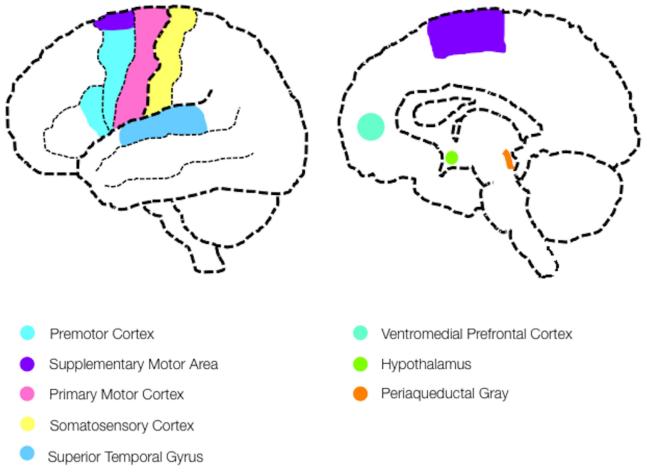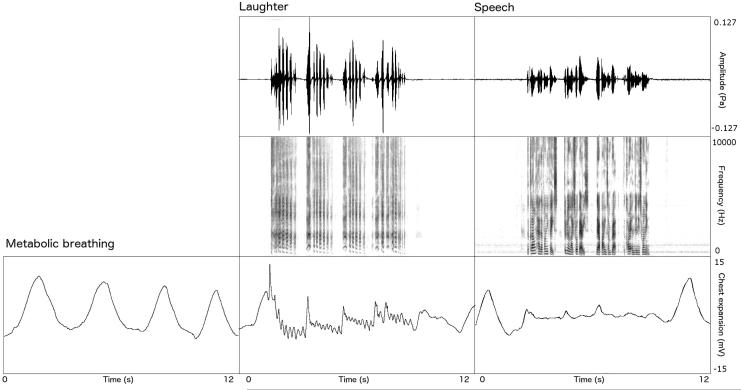Abstract
Laughter is often considered to be the product of humour. However laughter is a social emotion, occurring most often in interactions, where it is associated with bonding, agreement, affection and emotional regulation. Laughter is underpinned by complex neural systems, allowing it to be used flexibly: in humans and chimpanzees, social (voluntary) laughter is distinctly different from evoked (involuntary) laughter, a distinction which is also seen in brain imaging studies of laughter.
Keywords: Emotion, voice, conversation, laughter, motor control
When do we laugh, and why?
Human beings are immersed in laughter: it is a pervasive non-verbal expression of emotion (1,2), which is universally recognised (3), and is more like a different way of breathing than a way of speaking (4) (see Box One). Laughter is mediated strongly by social context: we are 30 times more likely to laugh if we are with someone else than if we are on our own (1, 2), and we laugh most of we can see and hear someone (even if this is via a computer) compared to voice or text interactions (5). Laughter is also highly behaviourally contagious, and can occur when primed solely by another’s laughter (2). Observational studies have shown that laughter is commonly found in conversations, where it occurs at the rate of around 5 laughs per 10 minutes of conversation (6). Strikingly, this is a much higher rate than the amount of laughter that people self-report (6). Furthermore, if we are asked about when we laugh, we report that we laugh at jokes and humour (1, 2): however, observational studies show that not only does most laughter occur in conversations, within those conversations most laughter is associated with statements and comments, rather than jokes (1, 2, 6). Furthermore, in conversation, the person who laughs most frequently is the person who has just spoken, indicating that laughter is frequently not a reaction to someone else’s utterance (6). Much conversational laughter, therefore, is an intentional, communicative act. For example, conversational laughter in both spoken and signed conversations is often timed to occur at the end of utterances (1): this commonality across modalities underlines the voluntary aspect of much of laughter production, since (at least in theory) a person could simultaneously sign and laugh if she wished to.
Box One. Breathing, speaking and laughing.
Upper panel shows oscillograms for speech and laughter, middle panel shows spectrograms for laughter and speech, lower panel shows chest expansion dynamics for metabolic breathing, laughing and speaking. The time scale on the x axis is the same for each (breathing, laughing and speaking). Both speaking and laughing are distinctly different from metabolic breathing, in terms of chest wall movements. Laughter is characterized by very rapid contractions of the intercostal muscles, resulting in large exhalations followed by individual bursts of laughter: the spectral modulation of laughter by supra-larangeal structures is minimal. Speech shows a fine pattern of intercostal muscle movements, which are used to maintain constant sub-glottal pressure at the larynx and to provide pitch and rhythm to the speech. Unlike laughter, speech also shows considerable spectral complexity reflecting movements of the supra-laryngeal articulators.
Consistent with this emphasis on the social roles of laughter, researchers have suggested that there are two different kinds of laughter, and that these are differentiated by how they are elicited: the laughter can be either driven by outside events (reactive, involuntary laughter) or be associated with a more intentional communicative act - i.e. more controlled, deliberate laughter (7). This has been overtly compared to a distinction between spontaneous and controlled smiling (7). Work with chimpanzees has revealed a similar distinction between laughter which is generated in reaction to being tickled, versus laughter which is produced during play (with the aim of making play last longer (8)).
Neural systems involved in the perception and production of laughter
The neural control of vocalization in humans is considered to involve two cortical systems acting on midbrain and brainstem motor structures, where lateral premotor and motor sites control the production of learned vocalizations such as speech and song, and a midline system involving the anterior cingulate and supplementary motor area is associated with the production of involuntary vocalizations, such as expressions of emotion (Jurgens, 2002). Within this framework of voluntary and involuntary vocalizations, Wild et al. (2003) (10) propose a model of laughter production, largely based on studies of pathological laughter, in which they identify a coordinating centre for laughter in the brainstem comprising the periaqueductal grey (PAG) and the upper reticular formation in the control of changes in facial expressions, respiration, and vocalization. These structures are proposed to receive excitatory inputs from cortical sites in the basal temporal and frontal lobes, as well as from structures in the limbic system including the hypothalamus and basal ganglia. Here, the lateral premotor cortices are implicated not in the basic production of laughter, but rather in the suppression and regulation of spontaneous laughter vocalizations. In line with this view, a recent neuroimaging study (11) found that the voluntary suppression of laughter during tickling involved greater BOLD responses in lateral sensorimotor cortex compared with when the participants were free to laugh when tickled (and when they voluntarily produced laughter without tactile stimulation). Another key difference between voluntary and (relatively) involuntary laughter in this study was a greater engagement of the hypothalamus during tickling laughter (compared with voluntary or suppressed laughter), and an additional correlation between activation in the PAG with the frequency of laughter episodes during tickling. Both of these findings suggest a central involvement of these structures in the production of basic, more automatic, expressions of positive experience.
Studies of the neural correlates of laughter perception have identified sensitivity to the social significance of laughter signals. In a study of passive listening to emotional vocalizations (12), sites on the lateral premotor and primary motor cortices showed a correlation with valence, being greater to positive sounds (laughter and cheers of triumph) and lower for negative sounds (screams of fear and expressions of disgust). This could reflect the contagiousness of laughter and the greater tendency for positive vocalizations and associated facial movements to occur in the context of social groups. However, more recent work (13) showed that direct comparisons of the neural responses to voluntary and involuntary laughter recordings gave no difference in motor cortex activation. Rather, the degree of engagement of sensorimotor cortices when listening to both types of laughter was related to individual differences in participants’ accuracy at classifying voluntary and involuntary laughs and “posed” and “real”, respectively. This could be evidence that the listener engages in some level of sensorimotor simulation as a mechanism for evaluating the social meaning of heard vocalizations, rather than exhibiting a basic sound-to-action response. In the same study, we observed preferential responses to involuntary laughter in bilateral auditory cortex, while responses to voluntary laughs were greater in ventromedial prefrontal cortex. This profile of auditory cortex engagement suggests that, on the one hand, there are acoustic hallmarks that automatically register the presence of intense, “real” laughter in the brain of the listener. In contrast, the absence or reduced prominence of such cues in voluntary laughs engages mentalizing strategies in medial prefrontal cortex, to support the interpretation of why the laugh has been produced, and what it means. Figure 1 summarizes the key sites identified in studies of the production and perception of laughter.
Figure 1. Voluntary and involuntary laughter in the brain.
The coordination of human laughter involves periaqueductal gray and the reticular formation with inputs from cortex, the basal ganglia and the hypothalamus [10]. The hypothalamus is more active during reactive laughter than voluntary laughter [11]. Motor and premotor cortices are involved in the inhibition of the brainstem laughter centres, and are more active when suppressing laughter than when producing it [11]. Laughter perception involves premotor cortex and SMA [12], while auditory and mentalizing regions showed differential engagement by involuntary and voluntary laughter [13].
Taking laughter seriously
Laughter is more than a positive emotional expression: its social use may extend to the management of affective states within interactions. Laughter is one of the positive emotional expressions which is expressly linked to a physiological reduction in the stressful reactions to negative emotions (e.g. fear, anger, disgust), in a way which may be more effective than other ways of managing negative emotions (e.g. suppression) (14, 15). Positive emotional expressions have been associated with the down-regulation of negative emotions in conversations between couples (14, 15): couples who reported the highest levels of marital satisfaction also showed the most ‘skillful’ use of positive affect (e.g. laughter) to regulate negative emotions during a difficult conversation (15). Laughter is therefore not simply a common emotional vocalization, which we use to establish and maintain social bonds (1,2): laughter may also simultaneously function as an essential behaviour for helping to ‘de-escalate’ negative emotional experience, with a positive role in both the short term affective state of the interaction, and the longer term state of relationships. Understanding the behavioural and neurobiological bases of laughter will mean more than thinking about jokes: it could provide a vital link between human language, relationships and emotional states.
References
- 1.Provine RR, Emmorey K. Laughter among deaf signers. J Deaf Stud Deaf Educ. 2006 Fall;11(4):403–9. doi: 10.1093/deafed/enl008. [DOI] [PMC free article] [PubMed] [Google Scholar]
- 2.Provine RR. Laughing, tickling, and the evolution of speech and self. Current Directions in Psychological Science. 2004;13:215–218. [Google Scholar]
- 3.Sauter DA, Eisner F, Ekman P, Scott SK. The universality of human emotional vocalisations. PNAS. 2010;107(6):2408–12. doi: 10.1073/pnas.0908239106. [DOI] [PMC free article] [PubMed] [Google Scholar]
- 4.Kohler KJ. ‘Speech-smile’, ‘speech-laugh’, ‘laughter’ and their sequencing in dialogic interaction. Phonetica. 2008;65(1-2):1–18. doi: 10.1159/000130013. doi: 10.1159/000130013. [DOI] [PubMed] [Google Scholar]
- 5.Vlahovic TA, Roberts S, Dunbar D. Effects of Duration and Laughter on Subjective Happiness Within Different Modes of Communication. Journal of Computer-Mediated Communication. 2012;17(4):436–450. [Google Scholar]
- 6.Vettin J, Todt D. Laughter in conversation: Features of occurrence and acoustic structure. Journal of Nonverbal Behavior. 2004;28(2):93–115. [Google Scholar]
- 7.Gervais M, Wilson DS. The evolution and functions of laughter and humor: A synthetic approach. Quarterly Review of Biology. 2005;80(4):395–430. doi: 10.1086/498281. [DOI] [PubMed] [Google Scholar]
- 8.Davila-Ross M, Allcock B, Thomas C, Bard KA. Aping Expressions? Chimpanzees Produce Distinct Laugh Types When Responding to Laughter of Others. Emotion. 2011;11(5):1013–1020. doi: 10.1037/a0022594. [DOI] [PubMed] [Google Scholar]
- 9.Jurgens U. Neural pathways underlying vocal control. Neuroscience and Biobehavioral Reviews. 2002;26:235–258. doi: 10.1016/s0149-7634(01)00068-9. [DOI] [PubMed] [Google Scholar]
- 10.Wild B, Rodden FA, Grodd W, Ruch W. Neural correlates of laughter and humour. Brain. 2003 Oct;126(Pt 10):2121–38. doi: 10.1093/brain/awg226. [DOI] [PubMed] [Google Scholar]
- 11.Wattendorf E, Westermann B, Fiedler K, Kaza E, Lotze M, Celio MR. Exploration of the Neural Correlates of Ticklish Laughter by Functional Magnetic Resonance Imaging. Cerebral Cortex. 2012 Jun;23(6):1280–9. doi: 10.1093/cercor/bhs094. [DOI] [PubMed] [Google Scholar]
- 12.Warren JE, Sauter DA, Eisner F, Wiland J, Dresner MA, Wise RJ, Rosen S, Scott SK. (2006) Positive emotions preferentially engage an auditory-motor “mirror” system. J Neurosci. 2006 Dec 13;26(50):13067–75. doi: 10.1523/JNEUROSCI.3907-06.2006. [DOI] [PMC free article] [PubMed] [Google Scholar]
- 13.McGettigan C, Walsh E, Jessop R, Agnew ZK, Sauter DA, Warren JE, Scott SK. Individual Differences in Laughter Perception Reveal Roles for Mentalizing and Sensorimotor Systems in the Evaluation of Emotional Authenticity. Cereb Cortex. 2013 Aug 22; doi: 10.1093/cercor/bht227. [DOI] [PMC free article] [PubMed] [Google Scholar]
- 14.Bloch L, Haase CM, Levenson RW. Emotion regulation predicts marital satisfaction: more than a wives’ tale. Emotion. 2014 Feb;14(1):130–44. doi: 10.1037/a0034272. doi: 10.1037/a0034272. [DOI] [PMC free article] [PubMed] [Google Scholar]
- 15.Yuan JW, McCarthy M, Holley SR, Levenson RW. Physiological down-regulation and positive emotion in marital interaction. Emotion. 2010 Aug;10(4):467–74. doi: 10.1037/a0018699. doi: 10.1037/a0018699. [DOI] [PubMed] [Google Scholar]




